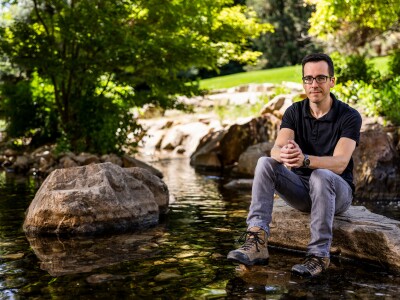In the past three decades, mule deer populations have been declining throughout the western U.S., in some areas by as much as 50 percent. Brigham Young University wildlife biologists are working with the Utah Division of Wildlife Resources on a large-scale, four-year project to identify reasons for this decline.
“Mule deer are an iconic species in the western U.S. The decline has been quite dramatic, from 20 to 50 percent depending upon where you are,” says Brock McMillan, a BYU professor of plant and wildlife sciences. “The herd is still healthy and there are still a lot of mule deer, but there is concern.”
BYU faculty and students are just completing their second year in a study of newborn fawns in south-central Utah. In order to identify survival rates and risks to the mule deer population, the team collared hundreds of newborn fawns and monitored them during the first six months of life.
Collecting data on newborn deer is grueling work, especially during fawning season when researchers need to locate and collar dozens of animals. Finding fawns is a difficult task since the population is spread over many miles and the fawns tend to be well hidden.
“Our goal is to collar 60 fawns each summer so during fawning season we typically have 8-10 people on the mountain every day. It takes that many man hours,” says McMillan.
“We have 20 days to catch our fawns and if we don’t then we don’t have a sufficient sample size,” says field technician Eric Freeman, a BYU graduate student. “So, during that time, we may work 90-100 hours a week, most days from 5:30 in the morning until around 10:30 at night.”
The process of locating newborn fawns actually begins in January when researchers capture adult does on the winter range, identify pregnant females and then implant the animals with transmitters. The transmitter is designed to activate when a fawn is born, making it possible to find the birth site in the spring.
Since older fawns are too difficult to catch and collar, the team must locate them when they are just a few hours to a couple of days old. When the mother deer and her fawn are located, the team waits for the mother deer to leave then moves in to measure the fawn and to place an elastic radio collar around its neck. They move quickly and take extra precautions to prevent abandonment by the mother.
“We’re like a pit crew,” says Freeman, who says they can complete the research and collaring process in about two minutes.
“The mother will only be about 100 yards away and then she’ll wait for us to leave and she’ll come right back to the fawn. We’ve never had a problem with fawns being abandoned,” says McMillan.
Over the past two summers, the team has collared more than 130 fawns which they then follow until the collar falls off (which, by design, happens at about six to eight months of age). During this time, they locate each animal several times per week, tracking survival rates and identifying specific causes of mortality.
“We know very little about the first few months of life,” says McMillan, who notes that mule deer fawns typically have only about 50% survival rate. “It’s important to know what the causes of success or failure are during the lifespan so that we can effectively manage the population.”
The mule deer study is a large-scaled collaboration among BYU, Utah State University, the Utah DWR, and wildlife conservation organizations, Sportsmen for Fish and Wildlife and the Mule Deer Foundation. The goal is to better understand the role of predators and other factors in population declines. The project also provides valuable research experiences for students.
“Most of the students who are involved want to be wildlife biologists. That’s their dream,” says BYU plant and wildlife sciences professor Randy Larsen. “This experience will help them get jobs, help them prepare for graduate school, and develop their careers.”
Writer: Video Photographer: Brian Wilcox










